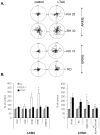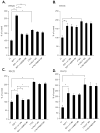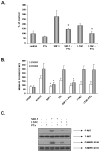Overlapping and distinct role of CXCR7-SDF-1/ITAC and CXCR4-SDF-1 axes in regulating metastatic behavior of human rhabdomyosarcomas
- PMID: 20162608
- PMCID: PMC2907445
- DOI: 10.1002/ijc.25245
Overlapping and distinct role of CXCR7-SDF-1/ITAC and CXCR4-SDF-1 axes in regulating metastatic behavior of human rhabdomyosarcomas
Abstract
We have demonstrated that the α-chemokine stromal-derived factor (SDF)-1-CXCR4 axis plays an important role in rhabdomyosarcoma (RMS) metastasis. With the recent description of CXCR7, a new receptor for SDF-1 that also binds the interferon-inducible T-cell α chemoattractant (ITAC) chemokine, we became interested in the role of the CXCR7-SDF-1/ITAC axis in RMS progression. To address this issue, we evaluated 6 highly metastatic alveolar (A)RMS and 3 less metastatic embryonal (E)RMS cell lines and found that all these cell lines express CXCR7. Although CXCR4 was expressed at a much higher level by highly metastatic ARMS lines, CXCR7 was present at a high level on ERMS lines. We also noticed that CXCR7 expression on RMS cells was downregulated in hypoxic conditions. More importantly, the CXCR7 receptor on RMS cell lines was functional after stimulation with ITAC and SDF-1 as evidenced by mitogen-activated protein kinase (MAPK)p42/44 and AKT phosphorylation as well as CXCR7 internalization, chemotaxis, cell motility and adhesion assays. Similarly to CXCR4, signaling from activated CXCR7 was not associated with increased RMS proliferation or cell survival. Moreover, CXCR7(+) RMS cells responded to SDF-1 and I-TAC in the presence of CXCR4 antagonists (T140, AMD3100). Furthermore, while intravenous injection of RMS cells with overexpressed CXCR7 resulted in increased seeding efficiency of tumor cells to bone marrow, CXCR7 downregulation showed the opposite effect. In conclusion, the CXCR7-SDF-1/ITAC axis is involved in the progression of RMS; targeting of the CXCR4-SDF-1 axis alone without simultaneous blockage of CXCR7 will be an inefficient strategy for inhibiting SDF-1-mediated prometastatic responses of RMS cells.
Figures







Similar articles
-
CXCR4-SDF-1 signaling is active in rhabdomyosarcoma cells and regulates locomotion, chemotaxis, and adhesion.Blood. 2002 Oct 1;100(7):2597-606. doi: 10.1182/blood-2002-01-0031. Blood. 2002. PMID: 12239174
-
Regulation of expression of stromal-derived factor-1 receptors: CXCR4 and CXCR7 in human rhabdomyosarcomas.Mol Cancer Res. 2010 Jan;8(1):1-14. doi: 10.1158/1541-7786.MCR-09-0259. Epub 2010 Jan 12. Mol Cancer Res. 2010. PMID: 20068066 Free PMC article.
-
Close correlation between CXCR4 and VEGF expression and frequent CXCR7 expression in rhabdomyosarcoma.Hum Pathol. 2014 Sep;45(9):1900-9. doi: 10.1016/j.humpath.2014.05.012. Epub 2014 Jun 12. Hum Pathol. 2014. PMID: 25086956
-
The role of stromal-derived factor-1--CXCR7 axis in development and cancer.Eur J Pharmacol. 2009 Dec 25;625(1-3):31-40. doi: 10.1016/j.ejphar.2009.04.071. Epub 2009 Oct 14. Eur J Pharmacol. 2009. PMID: 19835865 Free PMC article. Review.
-
Chemokine receptor trio: CXCR3, CXCR4 and CXCR7 crosstalk via CXCL11 and CXCL12.Cytokine Growth Factor Rev. 2013 Feb;24(1):41-9. doi: 10.1016/j.cytogfr.2012.08.007. Epub 2012 Sep 16. Cytokine Growth Factor Rev. 2013. PMID: 22989616 Free PMC article. Review.
Cited by
-
Evidence that vitronectin is a potent migration-enhancing factor for cancer cells chaperoned by fibrinogen: a novel view of the metastasis of cancer cells to low-fibrinogen lymphatics and body cavities.Oncotarget. 2016 Oct 25;7(43):69829-69843. doi: 10.18632/oncotarget.12003. Oncotarget. 2016. PMID: 27634880 Free PMC article.
-
The novel chemokine receptor CXCR7 regulates trans-endothelial migration of cancer cells.Mol Cancer. 2011 Jun 14;10:73. doi: 10.1186/1476-4598-10-73. Mol Cancer. 2011. PMID: 21672222 Free PMC article.
-
CXCL12-CXCR4/CXCR7 Axis in Cancer: from Mechanisms to Clinical Applications.Int J Biol Sci. 2023 Jun 26;19(11):3341-3359. doi: 10.7150/ijbs.82317. eCollection 2023. Int J Biol Sci. 2023. PMID: 37497001 Free PMC article. Review.
-
Vitronectin in the ascites of human ovarian carcinoma acts as a potent chemoattractant for ovarian carcinoma: Implication for metastasis by cancer stem cells.J Cancer Stem Cell Res. 2016;4:e1005. doi: 10.14343/JCSCR.2016.4e1005. Epub 2016 Nov 30. J Cancer Stem Cell Res. 2016. PMID: 28603747 Free PMC article.
-
CXCL12 / CXCR4 / CXCR7 chemokine axis and cancer progression.Cancer Metastasis Rev. 2010 Dec;29(4):709-22. doi: 10.1007/s10555-010-9256-x. Cancer Metastasis Rev. 2010. PMID: 20839032 Free PMC article. Review.
References
-
- Barr FG, Galili N, Holick J, Biegle JA, Rovera G, Emanuel BS. Rearrangement of the PAX3 paired box gene In the paediatric solid tumore alveolar rhabdomyosarcoma. Nat Genet. 1993;3:113–7. - PubMed
-
- Kelly KM, Womer RB, Barr FG. 3-FKHR and PAX7-FKHR fusions in rhabdomyosarcoma. J Pediatr Hematol Oncol. 1998;20:517–8. - PubMed
-
- Labura J, Drukala J, Majka M, Tomescu O, Navenot JM, Kucia M, Marquez L, Peiper SC, Barr FG, Janowska-Wieczorek A, Ratajczak MZ. CXCR4-SDF-1 signaling is active in rhabdomyosarcoma cells and regulates locomotion, chemotaxis, and adhesion. Blood. 2002;100:2597–606. - PubMed
-
- Kucia M, Reca R, Miekus K, Wanzeck J, Wojakowski W, Janowska-Wieczorek A, Ratajczak J, Ratajczak MZ. Trafficking of normal stem cells and metastasis of cancer stem cells involve similar mechanisms: pivotal role of the SDF-1-CXCR4 axis. Stem Cells. 2005;23:879–894. - PubMed
Publication types
MeSH terms
Substances
Grants and funding
LinkOut - more resources
Full Text Sources
Other Literature Sources

